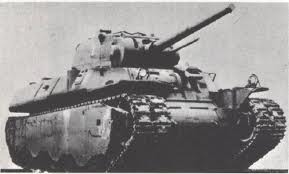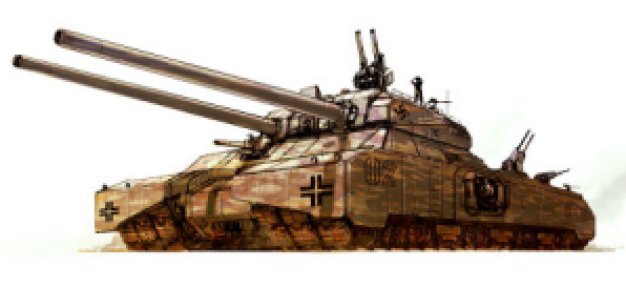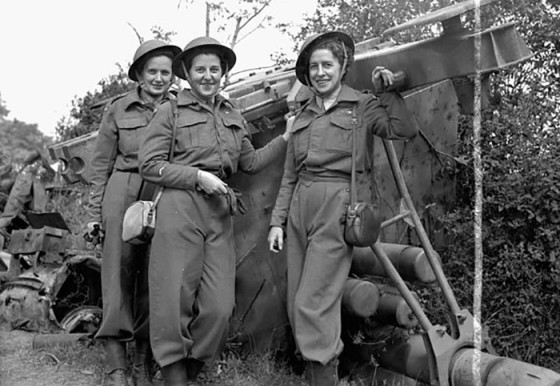
“Small, thinly armoured and under-gunned, the first tanks of World War Two were light-weights when compared to the lumbering beasts that would lurch off production lines within a few short years.”
TO UNDERSTAND JUST how ill-prepared the armies of the Second World War were for the scope and nature of the coming conflict, one need look no further than the tanks that rolled into battle in 1939.
Small, thinly armoured and under-gunned, the first tanks of World War Two were light-weights when compared to the lumbering beasts that would lurch off production lines within a few short years. Consider the Panzer II – the backbone of Germany’s tank corps for the invasions of Poland and France. The 16-foot long light tank carried a paltry 20-mm main gun and weighed in at a measly 9 tons. Within four years, Germany would be developing tanks like the Tiger II – a comparative monster of nearly 70 tons — seven times more than the earlier Mk. II. Also known as the King Tiger, the new war machine carried an 88-mm main gun, had a crew of five and was protected by up to 18 cm (more than half a foot) of armour plating in some places. A true giant, the Tiger II would actually have been dwarfed by even larger tanks had the war lasted long enough.
Here are a few of the ‘super tanks’ that were in the works.

United States
While the 30-ton M4 Sherman may very well be the United States’ most famous tank of the Second World War, it was smaller and largely inferior to German models like the Panther or the Tiger I and II. Fortunately for the Allies, American factories could produce far more Shermans than the Germans could Panzers. Between 1942 an 1945, the United States manufactured a staggering 53,000 tanks (President Roosevelt actually wanted even more built). Compare that with the approximate 7,500 Panthers and Tigers produced by Germany. Yet the Sherman wasn’t the heaviest tank the United States was working on during World War Two — not by a long shot.
The American M6 supertank might have rivalled the King Tiger had it been produced in large enough numbers to see service in World War Two. The 27-foot long, 57-ton machine carried a crew of five and featured two main guns: A 76-mm and a 37-mm. Only 40 were built before the U.S. Army abandoned the project. The only vehicles the M6 would ever go up against were ordinary automobiles — in the final year of the war M6s thrilled crowds by crushing old cars at War Bonds fundraising drives. Amazingly, the M6 itself might easily have been crushed under the treads of an even more ambitious tank being planned the United States.

The T-28 (see picture at the top), designated the Super-Heavy Tank in 1946, was originally planned to plow through fixed German defences like the Siegfried Line, while also making short work of the King Tiger. The Allies also hoped the T-28 would take part in Operation Downfall, the invasion of Japan. Also known as the T-95 105-mm Gun Motor Carriage, the T-28 was 36 feet long (10 feet longer than the King Tiger) and weighed nearly 100 tons. Without a rotating turret, the T-28 was more like a self-propelled gun or a tank destroyer than a conventional tank. Due to its immense size, it had a top speed of just 8 mph and an impractical range of less than 20 miles. Only two of the tanks were ever built and neither of those were constructed in time for the end of the war. One was dismantled after VJ Day, the other abandoned in a depot on a stateside U.S. Army base. It was rediscovered in 1974 and would go onto to be exhibited at Kentucky’s Patton Museum of Cavalry and Armor.

Great Britain
The British planned super tanks of their own, and fairly early in the war. The TOG1 and 2 were both 80-ton tanks designed to cross the same kinds of cratered and muddy fields of northern Europe that made mobility all but impossible on the Western Front of the First World War. The TOG 2, of which only a single prototype was ever constructed, was comprised of the turret of a British Challenger tank sitting atop a much larger chassis. Prototyped in 1941, it was the largest tank ever produced in the U.K. A few feet shorter than the American T-28, the TOG 2 carried a 76-mm, 17-pounder main gun and could reach speeds of 8.5 mph. Far too large, heavy and expensive for front line use, the TOG 2 program was eventually discontinued. The sole model is currently on display at the Tank Museum in Bovington, England.

France
France was defeated by Nazi Germany before it could put its 140-ton FCM F1 tank into production. Had it been manufactured, the FCM F1 would have easily been one of the largest tanks ever to rumble across a battlefield. The double turret tank was crewed by nine. The main turret featured a 90-mm gun. A smaller, lower set forward turret carried six machine guns and a 47-mm cannon. A classic example of generals planning on fighting the previous war, the FCM F1 was designed not to battle other tanks but to roll through First World War-era fixed fortifications. At the war’s outset France hoped to have enough of the tanks ready to break through enemy border defences beyond the Maginot Line and drive right into Nazi Germany. The offensive, which was planned for 1941, was preempted by the 1940 invasion of France, a campaign that saw German army use its lighter tanks to drive around the heavily fortified Maginot Line. The only FMC F1 to be produced was a wooded mock up.

Germany
By far The heaviest tank ever to be constructed was Germany’s Panzer VIII. And is designers weren’t without a sense of humour – they named the 180-ton goliath Maus (or mouse). Had the Maus’ manufacturing plant not been overrun by the Soviets in 1945, the Germans would have built more than just the single prototype. It featured two heavy guns in its turret: a 75-mm cannon along with an unbeatable 128-mm anti-armour weapon capable of destroying any other tank in use on the battlefield. Too heavy for any bridge, the Maus would have had to cross rivers submerged. Anticipating this, designers made the tank watertight and equipped it with a snorkel.

Even the mighty Maus would have been no match for Germany’s proposed Landkreuzers. More like navy destroyers on treads, these enormous 1,000-ton tanks would have made the Maus look like a child’s model by comparison. The L1000, designed in 1942 by engineers at Krupp, was planned to be more than 100 feet long and nearly as tall as a four-story building. Designated as the Ratte (or rat), the L1000 would have needed a crew of 40 to operate its two 280-mm guns, as well as a 128-mm cannon. It also would have carried its own battery of eight anti aircraft guns. Powered by up to eight marine diesel engines, the kind used to run e-boats and U-boats, the Ratte was intended to travel at speeds approaching 40 km/h and might have had a range of 200 kms. An even larger L1500 was proposed that would have dwarfed even the Ratte. Dubbed the Monster, the 1700-ton, 150-foot long beast would have

towered nearly 60 feet above the ground. It was designed to house a crew of more than 100 and would feature a turret-less 800-mm Schwerer Gustav railroad gun’ which was capable of hurling a seven-ton artillery shell nearly 30 miles. For smaller and closer targets, the Monster would also be equipped with two 150-mm cannons along with a virtual arsenal of AA guns and heavy machine guns. Powered by nearly 50 U-boat engines, the Monster would have rumbled along at 15 km/h crushing literally everything in its path. Hitler’s armaments minister, Albert Speer, recognized the impracticality of such ludicrously enormous war machines ordered the Landkreuzer projects scuttled.










I think these tanks give a nice testimony to the megalomania of WWII. Everything had to be bigger to be better. But if you look at the tanks developed post WWII, goes to show that you could achieve better results with smaller tanks.
I remember reading that the giant railroad guns probably did more harm to the nazi war effort than good. They consumed vast materials and required hundreds of men to operate with little ROI. The Landkreuzers probably would have done the same thing. 50 uboat engines? And think of the fuel required to run just one.
While Patton became a hero in the drive for Berlin, his “figure” became much more fabled with George C. Scott’s famous portrayal. But I would be curious to learn if Patton had any say-so in the development of these behemoths. Certainly, these lumbering giants may not have fit in his with vision of battle?
It’s funny that you should mention the George C. Scott role — whenever I read about Patton, I always picture Scott in my mind.
Isn’t it incredible how movies affect our perceptions? From the “Sands of Iwo Jima” and John Wayne’s portrayal of a gritty sergeant to Hanks in “Private Ryan”?
Only when you meet soldiers with a CIB or a decorated Marine who doesn’t talk about it is when you learn of what actually went on…
My Uncle Albert was machine gunned by an MG42 upon landing on Anzio. His landing craft ticket was a two way. Al lived to be 82. Never talked about it.
MG42s were beasts. Lucky he survived with a hundred bullets per minute.
And not the guy with the high squeaky voice. A paradox if there ever was one. He was six foot two or something, and was a direct descendant of Confederate Generals. Quite a few ex-pat Rebels moved to Southern California, like Patton’s family.
Surely, apart from the land ships, the “super heavies” are pretty normal?
The chally2 weighs in at seventy tons on wiki.
15 years of bolt ons and upgrades, cant imagine thats come down any.
Mallet
A bad idea, or just poor implementation?
The ententes ability to smash german transport links with battleship guns was a massive factor in the final breakouts?
Your blog is fantastic. But it can also be fantastical. Claiming the M6 could have been a match for the King Tiger is far too presumptuous of you. Besides no head to head combat data or stories, this thing never even fought against a Nerf gun,melt alone a massive Panzer.
Many of these say; “had it been…..”. Well, exaclty! Mostly they were concepts or thoughts. Even when built they were impractical. I enjoy reading about machines that were developed and saw some use, but most people with any common mechanical sense can dream most of them up in concept. I envision a 2 million ton super tank with a 1000mm main gun and 400 chain guns. Never happen, but I could draw you one. Good read, but a better title might have been “super tank concepts of WWII”……
your first picture is a T-95, NOT a T-28
The tank went by both designations: The T-28 Super Heavy Tank or the T-95 105 mm Gun Motor Carriage.
emm thay forgot the japanese ‘O-I’ that was going to be one of the biggest tanks EVER with eleven crew members a 105mm main gun aswell as having two extra turrets with flamethrowers in them and an onboard rocket launch pad.
Impossible!!! It can’t be!! The tank that you told us about had a rocket launch pad!!?!?!
While this is interesting, there some wrong information on this page. There should have been only about 7350 tigers and panthers produced not 15 000. The M4 sherman would have seen 53 000 from 1942-1945 not 1943. And to stack the 76mm M6 heavy against the King Tiger is foolish at best. Good site though.
All good points. The story was published four years ago so I’d have to do some digging to figure out where we got the production numbers, but your figures are verifiable.Thanks for pointing out the discrepancy.
I may know some proposed tanks. But I know only one super tank; the L1000 Landkrewzer. Because of this app, I know much about it. But the picture of the “land-ship” you used is not an original form. The original form only contain two 12” cannons and only four sets of anti-aircraft guns on it back.
That is a T-95 my friend then T meaning tonne and the 95 for how much it weighs. 95 tonne. The T-28 was the predecessor of this tank.
Actually it’s the same vehicle, the designation was changed.
Hi ! beginning of WW2, france got an unit of 10 tanks FCM 2C. Those tanks weight allready 70 tons !,
nice pictures and video here
https://forum.warthunder.com/index.php?/topic/392831-char-fcm-2c/